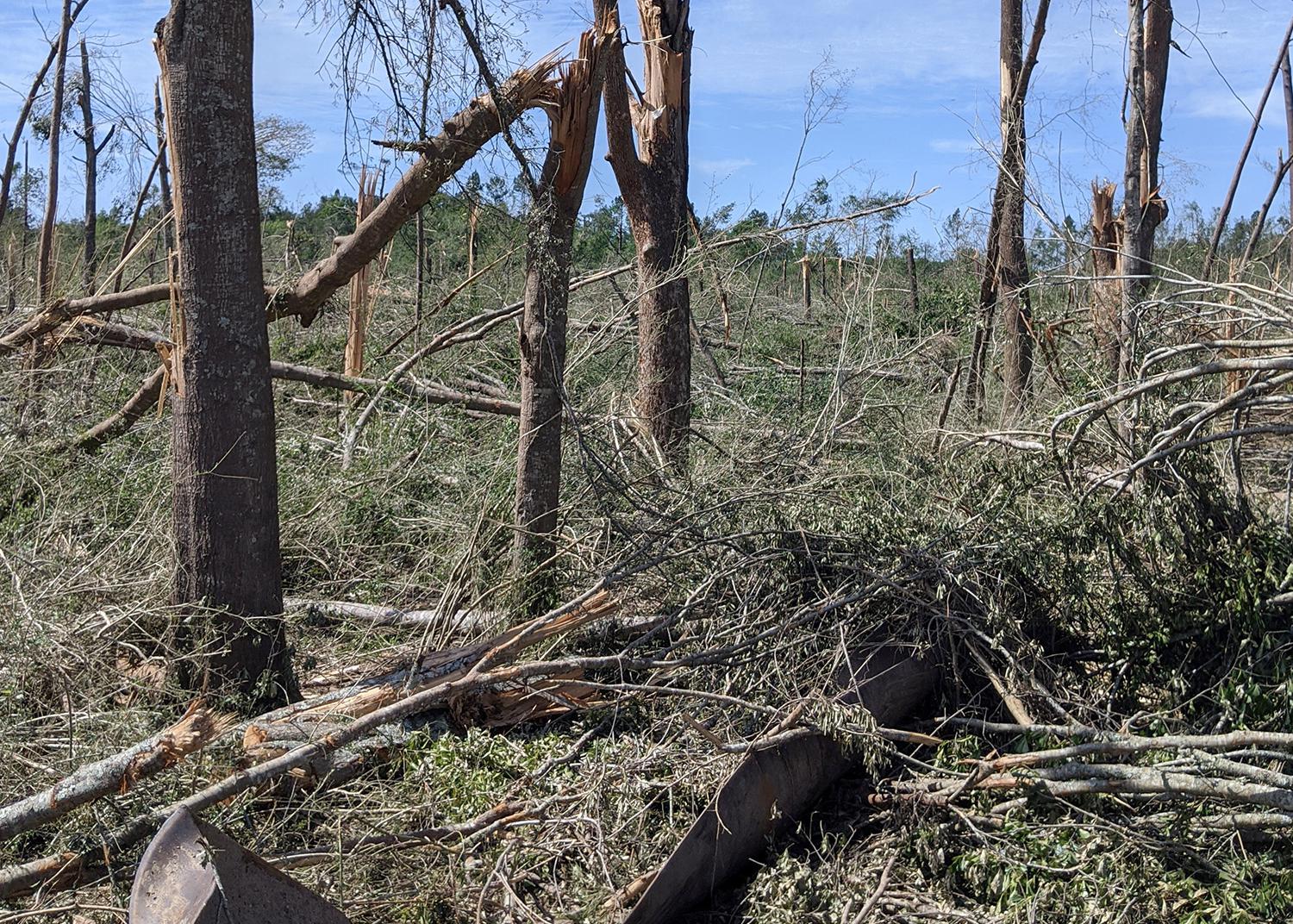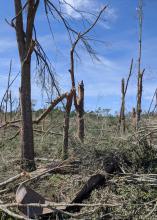Information Possibly Outdated
The information presented on this page was originally released on April 23, 2020. It may not be outdated, but please search our site for more current information. If you plan to quote or reference this information in a publication, please check with the Extension specialist or author before proceeding.
Extension explains steps in timber salvage process
RAYMOND, Miss. -- Easter Sunday’s severe weather and tornadoes left landowners in eight south Mississippi counties with battered timber stands.
According to estimates by the Mississippi Forestry Commission, around 13,000 total acres of timber in Covington, Jasper, Jefferson Davis, Jones, Lawrence, Marion, Smith and Walthall counties suffered about $14.9 million in damages.
“There were other storms that went across the northern part of the state, but we didn’t receive as much damage to our forest lands there. So those assessments haven’t been done yet,” said Marc Measells, Mississippi State University Extension Service forestry specialist.
South Mississippi landowners are now in the process of determining which timber they can keep and which is a loss. Measells shared some key steps that will help people through the process of salvaging storm-damaged timber.
First, gather existing records, including photos and tax documents. Be sure to record the damage with photos and written information. Contact a forester as soon as possible to help determine the amount of damage and make harvest decisions.
“A forester can help you through the entire process, from measuring the amount of damage to contacting buyers or loggers to harvest the timber,” Measells said.
Second, evaluate the timber stand. A proper evaluation will help landowners decide if a stand of timber can be saved and managed. Foresters will take into consideration the amount of each affected area that is occupied with undamaged trees, as well as the total volume of undamaged timber.
Stands that contain adequate areas of undamaged trees are considered manageable, and some with slightly more damage can still be rehabilitated and managed to final harvest. However, stands with more severe damage are considered unsalvageable from a timber management standpoint, Measells said.
Subsequently, foresters will measure the amount of damaged and undamaged sawtimber and pulpwood in a stand. Depending on the amount of each, they will recommend the next steps. That can include a wide range of possibilities.
“Going through these steps will help you make your ultimate management decision -- whether it’s salvaging the damaged timber only and managing the stand to final harvest or accepting the worst case scenario of pushing everything over and replanting the stand,” he said.
If stands contain salvageable timber, landowners should make decisions quickly because this wood is perishable.
The timeline for salvage ranges from 4 weeks to 12 months, depending on what species will be salvaged and what it will be used to make. For example, pine and hardwood timber intended for veneer and other appearance wood should be harvested within 4 to 6 weeks before blue stain fungus has time to damage the wood. Pine and hardwood that will be used for firewood can be harvested within 8 to 12 months.
Measells said landowners should expect to make less profit from storm-damaged timber.
“People often wonder why the prices they get are so much lower on damaged trees,” he said. “There are several reasons for that. One of the biggest is that it costs more and takes longer to harvest damaged stands. Other factors that decrease profits are the distance timber is hauled to a mill that will accept it, and the mill’s increased costs of processing it. Many times sawtimber is so damaged it has to be sold for pulpwood.”
Shaun Tanger, Extension forestry specialist, said some landowners may be able to claim a casualty loss on their taxes. Business and investment owners can claim this loss automatically. Personal or hobby owners can claim a casualty loss only when the area is a federally declared disaster area.
To claim a casualty loss, the property must be appraised, or an owner must provide the cost of cleanup and repair to determine the loss in fair market value.
“If you don’t have an appraisal done, the cost of cleanup and repair may be enough to show the decrease in fair market value, but there are a lot of restrictions on what can be included,” Tanger said. “If you claim a casualty loss, you must attempt a salvage sale. You must provide documentation of your efforts to salvage, and you probably will have a taxable gain associated with the salvage sale.”
Tanger recommends landowners consult with a tax attorney or a certified public accountant if they decide to salvage timber.
Landowners also may qualify for the Emergency Forest Restoration Program through the Farm Service Agency. The program provides funds for reforestation, debris removal, site preparation, fire lanes, restoration of roads, fuel breaks and erosion control structures.
For more information about salvaging timber, view Measells’ Salvaging Storm Damaged Timber video. For more information about tax implications and considerations, view Tanger’s video on Tax Implications of Storm-Damaged Timber.






